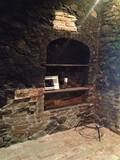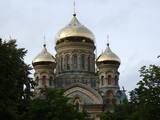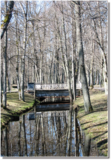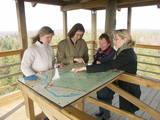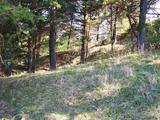| Nr | Name | Beschreibung |
|---|---|---|
|
The Jūrkalne People's Centre is the main gathering place for Suiti people and is in a former saloon that was built around 1875. Major restorations were conducted in 2011. The centre offers various events, there is an exhibition hall for visitors, and the "Maģie Suiti" ethnographic ensemble and other amateur ensembles are active there. If you want to meet the Suiti and learn about their traditions, contact the centre in advance. |
||
|
Atrodas austrumos no Alūksnes Tempļa kalna un dienvidos no Lieliem kapiem – Tempļa kalna parkā. Skatu torņa platforma atrodas apmēram 30 m augstumā virs Alūksnes ezera ūdeņiem. Labi redzama Marijas sala, Alūksnes parks, Alūksnes ezera piekraste līdz Kolberģim un Lāzberģim. Izcili ainavisks skats! |
||
|
Das Gotteshaus ist von 1900 bis 1903 im byzantinischen Stil als eine Kirche der Kriegsgarnison gebaut worden, bei deren Einweihung Zar Nikolai II teilgenommen hat, indem der Heilige Nikolai – der Schutzpatron der Seeleute geehrt wurde. Das prachtvolle Gebäude wurde während des Ersten Weltkriegs von den Deutschen ausgeraubt. Während der Ersten Republik Lettlands diente die Kathedrale als das Gotteshaus der Garnisone von Liepaja. Die Sowjetarmee hat die Räume des Gotteshauses als das Kino des Sport- und Matrosenklubs und als ein Lager benutzt. Es gibt Erzählungen darüber, dass die Sowjetsoldaten aus den Heiligenbildern der Fassade Teile von Goldmosaiken herausgebrochen haben. Heute wirtschaftet in der Kirche die orthodoxe Gemeinde. Beim Bau der Kathedrale ist eine einzigartige Technologie der ununterbrochenen Betonierung verwendet worden, darum haben die Baukonstruktionen keine Stützsäulen und ihr Gewicht nur auf die Gebäudewände stützt, die die vier sich kreuzenden Bogengewölbe halten. Heute ist dieses Gotteshaus die höchste orthodoxe Kathedrale in Lettland. |
||
|
Dieser Hof ist ein der historischen Region Sēlija charakteristischer Hof mit seiner Planung und den typischen Gebäuden, und als solcher ist er einer der seltenen Höfe, der öffentlich zugänglich und zu besichtigen ist. Der Hof Gulbji befindet sich ziemlich weit von größeren Straßen und anderen Ortschaften. Er ist auf der sogenannten Insel Dronkusala, unweit von dem Ort zu finden, wo das Urstromtal von Dviete anfängt. Die Besitzer des Hofes haben viele alte Haushaltsgegenstände gesammelt. Die Besucher können hier die Wirtschaft und eine Sammlung von Heilkräutern besichtigen, sowie die Gerichte der Region probieren oder die Rauchsauna besuchen. Man kann sagen, dass die Besitzer des Hofes in einer Naturalwirtschaft wohnen, indem sie die Traditionen der historischen Region pflegen. Lettische Küche: Dünne Pfannkuchen, Graupensuppe, dickflüssige Kartoffelsuppe, geschmorte Bohnen in einer besonderen Soße, lettischer Grießpudding Buberts, Brotsuppe mit Schlagsahne, Torten, Kräutertees. Das besondere Gericht: Zeppeline. |
||
|
Vēršupīte (Fluss) – die Brocēnu Straße überquert die
Vēršupīte, die sich durch Ķemeri windet. Sie ist mit 12
kleinen und romantischen Brücken beschmückt. Jede
der Brücken hat einen Namen.
|
||
|
Das Café befindet sich im Keller des Kulturhauses von Ligatne. Im Sommer ist neben dem Fluss Ligatne eine Sommerterrasse eingerichtet. Lettische Küche: Hering, kalte Suppe, Bratwürste, Schweinfleischfrikadellen, Jagdwürste, Schweinerippen, Pfannkuchen mit Quark, Kartoffelpfannkuchen. Das besondere Gericht: Schweinschnitzel "Pie Jančuka". |
||
|
Die Wirtin backt echtes lettisches Landbrot in einem mit Holz heizbaren Lehmofen. Der Teig wird aus Roggen- und Weizenmehl, Salz, Zucker, Kümmeln und natürlichem Sauerteig vorbereitet. Die Besucher können das Brotbacken beobachten und daran auch teilnehmen, sowie das Brot probieren und kaufen. Auf dem Hof kann man eine Altertümer-Sammlung besichtigen. Das zum Brotbacken verwendete Getreide ist aus dem eigenen Hof, wo es umweltfreundlich angebaut wird! |
||
|
Путешествие для гурманов и любителей путешествий, в котором будет возможность попробовать не только традиционные курземские блюда, как скландраусис и копчушка, но и блины, приготовленные из свежемолотой муки, крестьянский сыр, домашнее вино и другие дары села. Кроме дегустации даров села, будет возможность пройтись по природным тропам и познакомиться с культурно-историческим наследием. Информация о маршруте от Latvijas Lauku forums |
||
|
Das Restaurant befindet sich in der Altstadt von Liepaja, im Hotel Līva, und bietet eine Speisekarte mit lettischen Gerichten und Gerichten aus der ganzen Welt an. Für die Vorbereitung der Gerichte werden auch selbstgezüchtete Gewürzpflanzen verwendet. Lettische Küche: Leicht gesalzener Hering mit Quark, gefüllte dünne Pfannkuchen, Kartoffelpfannkuchen, geschmorte Schweinerippen, Hirschfleisch mit Wacholderbeeren, gebratener Entenschenkel, gebratenes Zanderfilet mit Buchweizen, geräuchertes Heringsfilet. Das besondere Gericht: Liepājas menciņi (Kabeljau von Liejapa) geräucherter Kabeljau mit Kartoffeln, Zwiebeln und Dillen in einem Keramiktopf. |
||
|
Das erste Gotteshaus in Vecpiebalga war 1345 erbaut worden, das nächste 1834-1845 unter der Bauleitung des livländischen Baumeisters Mārčis Sārums. Dieses war im Herbst 1944 zerstört und von 1995-1997 nach Plänen der Architektin Ausma Skujiņa wieder aufgebaut worden. Im Altar der Kirche befindet sich das Altargemälde „Christus wandelt im Land Piebalga“ von Jūlijs Jēgers. Neben dem Gotteshaus befindet sich ein Gedenkstein für politisch Unterdrückte. |
||
|
Ložmetējkalns in Tīreļpurvs ist ein historisches Denkmal von nationaler Bedeutung – einziger kulturhistorischen Schutzgebiet in Lettland (der Gedenkpark der Weihnachtskämpfe). Es lohnt sich, den erneuten Aussichtsturm hinaufzusteigen. Von diesem Turm hinaus kann man der Morast Maztīrelis mit der ehemahliger deutschen Schmalspurbahn, die der Morast in Nord – südlicher Richtung durchquert (eine Reihe von größeren Bäumen in der Natur) besichtigen. In der Umgebung der Häuser von Ložmetējkalns, Tīreļpurvs und Mangaļi sind für baltische Staaten einzigartige Zeugnisse über die Fortifikationsgebäuden des I Weltkrieges, als auch über die an diesem Platz geführten Weihnachtskämpfe erhalten geblieben. In Mangaļi ist es möglich die Exposition über die Kämpfe anzusehen, zum Beispiel sogenannter "Deutscher Wall " u.a. Die Besucher haben die Möglichkeit in Begleitung eines gebildeten Reiseführers das Territorium zu besichtigen. Im Park findet auch thematische und bildende Maßnahmen statt.
|
||
|
Kirkas Hill in Micāni. In 1792, a small castle on the hill Priežukalns (Kirkas kalns) was rebuilt into
Lutheran Church. Nowadays, the hill still is called Kirkas kalns (in German „Kirche” means „church”).
Old people say – under the church there is a big cellar where the jewellery of church and the Mantefel
family is hidden; Manteifel family vault is there too.
|
||
|
Taka izveidota 2005. gadā. Tā atrodas uz Lapmežciema un Bigauņciema robežas un izskatās kā koka dēlīšu laipa gar Siliņupi. Taka aizved līdz jūrai, kur apskatāms vecais Lapmežciema mols. Siliņupē novērojami ūdensputni. |
||
|
Befindet sich im Park von Lielvārde, in der Anfang des 19.Jh. erbauten Scheune des Herrenhauses Lielvārde, die später auch als Wohngebäude genutzt worden war. 1922 war eine Veranda angebaut worden. Das Museum befindet sich in diesem Gebäude seit 1970 und in dessen Sammlung gibt es Materialien über das lettische Volksepos “Lāčplēsis“(der Bärenzerreißer) und dessen Autor Andrejs Pumpurs (1841-1902), sowie über die Geschichte und die Ethnografie des Kreises Lielvārde. Neben dem Museum liegt ein großer Stein – das Bett des Lāčplēsis (etwa 80t) und ein Bruchstück, das „die Decke des Lāčplēsis“ genannt wird. Beide Steine befanden sich einst in der Daugava, neben der Insel von Lielvārde, über die heute die Wasser des Kraftwerkes fließen. Direkt daneben kann man den Holzklotz der Spīdala sehen, der von Aizkraukle hierher gebracht worden war. |
||
|
The Brasla River flows through a lovely valley that is approximately 300 m wide and up to 30 m deep. It is near the Inčukalns-Valka highway. The river has among the most beautiful rapids in the country, with mighty cliffs (the Brasla cliffs) that can be seen at nearly every curve in the river (except along the lowest reaches of the river). During the winter, various unusual frozen waterfalls can be seen in some of the cliffs, including the Krauļukalns cliff and the Jāņavārti cliff. On the left bank of the Brasla, opposite the Brasla fish farm, there are the Aņīte cliffs -- a series of sandstone cliffs that are 1 km long. The cliffs are between 2 and 35 m in height, and the sandstone cliffs are separated by ravines. On the right bank of the Brasla, there are major cliffs such as the Vāršavu cliff, the Kraukļukalns cliff, the Jāņavārti cliff, the Slūnu cliff, the Virtaka cliff and the Buļi cliff. How can you best learn about them? Boat down the river from the aforementioned highway or even from Straupe, which is further upstream. An alternative is hiking down the right bank of the river, though please take into account that the terrain is fairly extreme, and you are going to have to think about what to do when you arrive at the place where the Brasla River flows into the Gauja. |
||
|
Apmeklētāju centrā var iegūt noderīgu informāciju un iepazīt ekspozīciju par Karulas augstienes veidošanās vēsturi, ezeru iemītniekiem un šejienes novada kultūrvēsturiskajām tradīcijām. Apmeklētāju grupas semināru zālē var noskatīties izzinošu prezentāciju. |
||
|
Der „Hof der lauten Stille“ befindet sich am Hang zum Ufer eines Altarms des Nevėžys. Hier werden „glückliche Nahrungsmittel“ hergestellt, ausschließlich aus dem, was auf dem eigenen Hof erzeugt wird. |
||
|
Der Laden des Bauernhofs Lepaniidi befindet sich nur 15 Autominuten von Kärdla entfernt. Im Bauernhof werden Ziegen und Schafe gezüchtet sowie verschiedenes Gemüse angebaut. |
||
|
Guides will offer you a tour during which you can watch red deer, fallow deer and wild sheep. You will learn about the specifics of breeding them. The farm engages in selection, as well. |
||
|
Visiting a blacksmith has always been something special. Does this job still exist, and is it still importance? Some may wonder who is a blacksmith is in the first place. The DUDU Nests open-air smithy will answer all of your questions. The blacksmith will teach you all about his profession, talking about the tools and materials that are necessary, the relevant traditions and the everyday work of blacksmiths today. You can forge your own nail to test the difficulty of the work. The blacksmith will happily attend your event with his open-air forge. This is perfect for students, smaller children, wedding guests or individual visitors.
|
||
